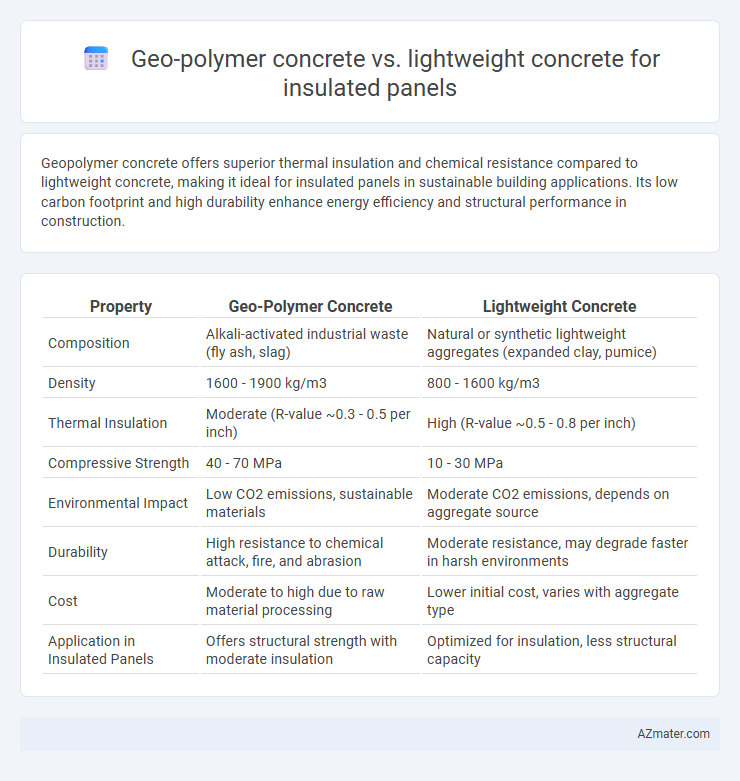Geopolymer concrete offers superior thermal insulation and chemical resistance compared to lightweight concrete, making it ideal for insulated panels in sustainable building applications. Its low carbon footprint and high durability enhance energy efficiency and structural performance in construction.
Table of Comparison
| Property | Geo-Polymer Concrete | Lightweight Concrete |
|---|---|---|
| Composition | Alkali-activated industrial waste (fly ash, slag) | Natural or synthetic lightweight aggregates (expanded clay, pumice) |
| Density | 1600 - 1900 kg/m3 | 800 - 1600 kg/m3 |
| Thermal Insulation | Moderate (R-value ~0.3 - 0.5 per inch) | High (R-value ~0.5 - 0.8 per inch) |
| Compressive Strength | 40 - 70 MPa | 10 - 30 MPa |
| Environmental Impact | Low CO2 emissions, sustainable materials | Moderate CO2 emissions, depends on aggregate source |
| Durability | High resistance to chemical attack, fire, and abrasion | Moderate resistance, may degrade faster in harsh environments |
| Cost | Moderate to high due to raw material processing | Lower initial cost, varies with aggregate type |
| Application in Insulated Panels | Offers structural strength with moderate insulation | Optimized for insulation, less structural capacity |
Introduction to Insulated Panels
Insulated panels commonly use materials like geo-polymer concrete and lightweight concrete due to their thermal efficiency and structural benefits. Geo-polymer concrete offers enhanced durability and fire resistance with low carbon emissions, making it a sustainable choice for insulated panels. Lightweight concrete provides excellent insulation properties and ease of handling, which improves overall panel performance in energy-efficient building designs.
Overview of Geo-polymer Concrete
Geo-polymer concrete is an innovative, eco-friendly building material synthesized from industrial waste such as fly ash and slag, offering superior durability and thermal resistance compared to traditional Portland cement. Its high compressive strength, low thermal conductivity, and enhanced fire resistance make it ideal for insulated panels in sustainable construction. The reduced carbon footprint and excellent performance in thermal insulation position geo-polymer concrete as a strong alternative to lightweight concrete in modern insulated panel applications.
Overview of Lightweight Concrete
Lightweight concrete is a construction material characterized by its lower density compared to conventional concrete, typically achieved by incorporating lightweight aggregates such as expanded clay, pumice, or perlite. This type of concrete offers enhanced thermal insulation properties, making it ideal for insulated panels used in energy-efficient building envelopes. Its reduced weight contributes to easier handling and lower transportation costs, while still providing adequate structural performance and fire resistance.
Material Composition Comparison
Geopolymer concrete for insulated panels primarily consists of industrial by-products like fly ash or slag activated by alkaline solutions, creating a dense, durable matrix with low thermal conductivity. Lightweight concrete incorporates lightweight aggregates such as expanded clay, shale, or pumice, resulting in a porous structure that reduces density and improves thermal insulation. The geopolymer mix offers superior fire resistance and environmental benefits, while lightweight concrete emphasizes ease of handling and enhanced insulation through its aggregate composition.
Thermal Insulation Properties
Geo-polymer concrete exhibits superior thermal insulation properties compared to lightweight concrete, primarily due to its dense molecular structure and low thermal conductivity ranging between 0.16 to 0.35 W/m*K. Lightweight concrete provides moderate insulation with thermal conductivity typically between 0.20 to 0.50 W/m*K but is less efficient in maintaining temperature stability under cyclic thermal loads. Insulated panels utilizing geo-polymer concrete achieve enhanced energy efficiency and durability, making them ideal for sustainable building applications requiring high thermal resistance.
Structural Strength and Durability
Geo-polymer concrete exhibits higher compressive strength and superior resistance to chemical attacks compared to traditional lightweight concrete, making it ideal for insulated panels requiring enhanced structural integrity. Lightweight concrete offers reduced density and improved thermal insulation but may suffer from lower load-bearing capacity and increased susceptibility to cracking under stress. The durability of geo-polymer concrete outperforms lightweight variants due to its dense microstructure and minimal shrinkage, ensuring longer-lasting insulated panels in demanding environmental conditions.
Environmental Impact and Sustainability
Geo-polymer concrete for insulated panels significantly reduces carbon emissions by utilizing industrial waste such as fly ash and slag, leading to lower embodied energy compared to conventional lightweight concrete made primarily from cement and aggregates. Lightweight concrete panels, while offering thermal insulation benefits, often rely on energy-intensive manufacturing processes and non-renewable raw materials, resulting in a higher environmental footprint. The superior sustainability profile of geo-polymer concrete supports circular economy principles and promotes long-term environmental resilience in building insulation applications.
Cost Analysis and Economic Feasibility
Geo-polymer concrete offers cost advantages over lightweight concrete for insulated panels due to its utilization of industrial by-products like fly ash, reducing raw material expenses and environmental impact. Lightweight concrete incurs higher material and processing costs from specialized aggregates and foaming agents, impacting overall project budgets. Economic feasibility studies highlight geo-polymer concrete's potential for long-term savings through enhanced durability, lower maintenance, and reduced embodied energy despite initial formulation complexity.
Applications in Building Systems
Geo-polymer concrete offers superior fire resistance, chemical durability, and environmental sustainability, making it ideal for insulated panels in commercial and industrial building systems requiring enhanced thermal insulation and structural performance. Lightweight concrete provides excellent thermal insulation and reduces structural load, commonly used in residential and multi-story buildings to improve energy efficiency and ease of installation. Both materials contribute to sustainable construction practices, but geo-polymer concrete excels in applications demanding higher durability and environmental impact reduction.
Future Trends and Innovations
Geo-polymer concrete offers significant sustainability advantages over lightweight concrete by reducing carbon emissions through the use of industrial byproducts like fly ash and slag, aligning with future green building trends. Innovations in geo-polymer formulations enhance thermal insulation, durability, and fire resistance, making it increasingly suitable for insulated panels in energy-efficient construction. Lightweight concrete continues to evolve with advanced admixtures and nanomaterials that improve strength-to-weight ratio and thermal performance, but geo-polymer composites show greater potential for circular economy integration and long-term environmental benefits.

Infographic: Geo-polymer concrete vs Lightweight concrete for Insulated panel
 azmater.com
azmater.com